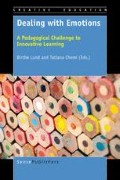Abstract
This chapter analyses students’ emotional and behavioural reaction to pedagogical challenges when learning to innovate. The analysis found that creative learning processes were sensitive to partnership and external factors, such as time, evaluation procedures and values.
Access this chapter
Tax calculation will be finalised at checkout
Purchases are for personal use only
Preview
Unable to display preview. Download preview PDF.
References
Ahmad, N., & Seymour, R. G. (2008). Defining entrepreneurial activity: Definitions supporting frameworks for data collection, OECD Statistics Working Paper 2008/1). Paris: OECD. Retrieved February 15, 2015 from http://www.oecd.org/std/definingentrepreneurialactivitydefinitionssupportingframeworksfordatacollection.htm
Amabile, T. M. (1983). The social psychology of creativity. New York, NY: Springer Verlag.
Amabile, T. M. (1996). Creativity in context: Update to “The social psychology of creativity”. Boulder, CO: Westveiw.
Apple, M. W. (1971). The hidden curriculum and the nature of conflict. Interchange, 2(4), 27–40.
Bassanini., & Scarpetta. (2001). The driving forces of economic growth: Panel data evidence for the OECD countries. OECD Economic Studies, 33(2), 9–56.
Clark, J. (2015). Philosophy, neuroscience and education. Educational Philosophy and Theory, 47(1), 36–46.
Csikszentmihalyi, M. (1988). Society, culture and person: A systems view of creativity. In R. Sternberg (Ed.), The nature of creativity: Contemporary psychological perspectives. New York, NY: Cambridge University Press.
Csikszentmihalyi, M. (1997). Creativity: The flow and the psychology of discovery and invention. New York, NY: Harper Perennial.
Csikszentmihalyi, M. (1999), Implications of a systems perspective for the study of creativity. In R. Sternberg (Ed.), Handbook of creativity. Cambridge, UK: Cambridge University Press.
Damasio, A. R. (1999). The feeling of what happens: Body and emotion in the making of consciousness. Orlando, FL: Harcourt.
Dewey, J. (1920). How we think. Boston, MA: Heath
Dewey, J. (1938). Experience and education: Kappa Delta Pi. New York, NY: Touchstone edition
Ford, C. M. (1996). A theory of individual creative action in multiple social domains. Academy of Management Review, 21(4), 112–1142.
Gardner, H. (1991). The unschooled mind: How children think and how schools should teach. New York, NY: Basic Books
Jackson, P. W. (1968). Life in classrooms. New York, NY: Holt, Rinehart, & Winston.
Jensen, T. W., & Skov, M. (2007). Følelser og kognition, en indledning. In T. W. Jensen & M. Skov (Eds.), Følelser og kognition. Copenhagen: Museum Tusculanums Forlag
Lankoski, P. (2007). Goals, affects, and empathy in games. Philosophy of computer games.
Liljestrom, A., Roulston, K., & deMarrais, K. (2007). There’s no place for feeling like this in the workplace: Woman teachers’ anger in school settings. In P. A. Schutz & R. Perkrun (Eds.), Emotion in education. Amsterdam, The Netherlands: Elsevier Science.
Lund, B. (2010). Innovation strategies in school. In K. Skogen (Ed.), Creativity and innovation: Preconditions for entrepreneurial education. Trondheim: Tapir Akademisk Forlag
Meyer, D. K., & Turner, J. C. (2007). Scaffolding emotions in classrooms. In P. A. Schutz & R. Perkrun (Eds.), Emotion in education. Oxford, UK: Elsevier Science
Ministeriet for Videnskab, Teknologi og Udvikling. (2010). Strategi for uddannelse I entreprenørskab. Retrieved February 15, 2015 from http://ufm.dk/publikationer/2010/filer-2010/strategi-forentreprenoerskab.pdf
Morris, J. A., & Feldman, D. C. (1996). The dimensions, antecedents, and consequences of emotional labor. Academy of management review, 21(4), 986–1010.
New & Improved. (2004). Managing emotions to foster innovation. The innovative brain: A new and improved newsletter. Retrieved February 15, 2015 from http://www.newandimproved.com/newsletter/1125.php
Newell, A., Shaw, J. C., & Simon, H. A. (1962). The processes of creative thinking. In H. E. Gruber, G. Terrell, & M. Wertheimer (Eds.), Contemporary approaches to creative thinking. New York, NY: Atherton Press
Nordisk Ministerråd. (2011). Kreativitet, innovation og entreprenørskab i de nordiske uddannelsessystemer – fra politiske hensigtserklæringer til praktisk handling. (No. ANP 2011:706). Copenhagen: Mandag Morgen. Retrieved February 15, 2015, from www.cko.dk/sites/default/files/kreativitet_innovation_og_entreprenoerskab_i_de_nordiske_uddannelsessystemer.pdf
Ottesen, E., Lund, B., Grams, S., Aas, M., & Prøitz, T. S. (2013). Educational methods as commoditieswithin European education: A Norwegian–Danish case. European Educational Research Journal, 12(4), 463–479
Pekrun, R. (2007). The control-value theory of achievement emotions: An integrative approach to emotions in education. In P. A. Schutz & R. Perkrun (Eds.), Emotion in Education. San Diego, CA: Elsevier Science.
Runco, M. A. (2007). Creativity: Theories and themes: Research, development, and practice. Amsterdam, he Netherlands: Elsevier.
Runco, M. A. (2014). Creativity: Theories and themes: Reseach, development, and practice. Burlington, MA: Elsevier.
Sawyer, R. K. (2006). Explaining creativity – the science of human innovation. Oxford, Uk: University Press.
Schutz, P. A. (2007). Teacher identities, beliefs and goals related to emotions in the classroom. In P. A. Schutz & R. Perkrun (Eds.), Emotion in Education. San Diego, CA: Elsevier Science.
Searle, J. R. (1984). Minds, brains, and science. Cambridge, MA: Harvard University Press.
Sternberg, R. (2006). The nature of creativity. Creativity Research Journal, 18(1), 87–98.
The glossary of Education reform. (2014). Student engagement. Retrieved February 15, 2015 from http://edglossary.org/student-engagement/
The Oslo Agenda for Entrepreneurship Education in Europe. (2006). Entrepreneurship education in Europe: Fostering entrepreneurial mindsets through education and learning, Final report. Retrieved February 15, 2015 from ec.europa.eu/enterprise/policies/sme/files/ support_measures/ training_education/doc/oslo_report_final_2006_en.pdf
U.S. Department of Education, Office of Special Education and Rehabilitative Services, Office of Special Education Programs. (2003). Identifying and treating attention deficit hyperactivity disorder: A resource for school and home. Washington, DC: Author.
Zembylas, M. (2003). Emotions and teacher identity: A poststructural perspective. Teachers and Teaching: Theory and Practice, 9(3), 213–238
Zembylas, M. (2007). The power of politics of emotions in teaching. In P. A. Schutz & R. Perkrun (Eds.), Emotion in education. San Diego, CA: Elsevier Science.
Author information
Authors and Affiliations
Editor information
Editors and Affiliations
Rights and permissions
Copyright information
© 2015 Sense Publishers
About this chapter
Cite this chapter
Lund, B. (2015). The Notion of Emotion in Educational Settings When Learning to Become Innovative and Creative. In: Lund, B., Chemi, T. (eds) Dealing with Emotions. Creative Education Book Series. SensePublishers, Rotterdam. https://doi.org/10.1007/978-94-6300-064-2_1
Download citation
DOI: https://doi.org/10.1007/978-94-6300-064-2_1
Publisher Name: SensePublishers, Rotterdam
Online ISBN: 978-94-6300-064-2
eBook Packages: Humanities, Social Sciences and LawEducation (R0)

